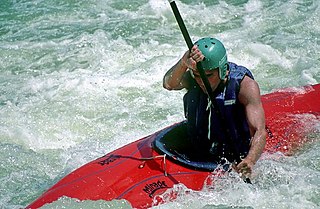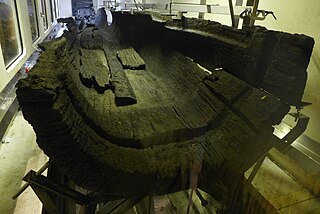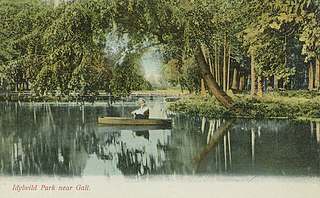Smooth curve hulls are hulls that are rounded and do not usually have any chines or corners. They can be moulded, round-bilged or soft-chined. Examples are the round bilge, semi-round bilge and s-bottom hull.
Smooth curve hulls are hulls that are rounded and do not usually have any chines or corners. They can be moulded, round-bilged or soft-chined. Examples are the round bilge, semi-round bilge and s-bottom hull.

A hull is the watertight body of a ship, boat, submarine, or flying boat. The hull may open at the top, or it may be fully or partially covered with a deck. Atop the deck may be a deckhouse and other superstructures, such as a funnel, derrick, or mast. The line where the hull meets the water surface is called the waterline.

A kayak is a small, narrow human-powered watercraft typically propelled by means of a long, double-bladed paddle. The word kayak originates from the Inuktitut word qajaq. In British English, the kayak is also considered to be a kind of canoe.

Boat building is the design and construction of boats — and their on-board systems. This includes at minimum the construction of a hull, with any necessary propulsion, mechanical, navigation, safety and other service systems as the craft requires.

Clinker-built, also known as lapstrake-built, is a method of boat building in which the edges of longitudinal (lengthwise-running) hull planks overlap each other. Where necessary in larger craft, shorter hull planks can be joined end to end, creating a longer hull plank (strake).

On a vessel's hull, a strake is a longitudinal course of planking or plating which runs from the boat's stempost to the sternpost or transom. The garboard strakes are the two immediately adjacent to the keel on each side.

Sharpies are a type of hard chined sailboat with a flat bottom, extremely shallow draft, centreboards and straight, flaring sides. They are believed to have originated in the New Haven, Connecticut region of Long Island Sound, United States. They were traditional fishing boats used for oystering, and later appeared in other areas. With centerboards and shallow balanced rudders they are well suited to sailing in shallow tidal waters.

Philip C. Bolger was a prolific American boat designer, who was born and lived in Gloucester, Massachusetts. He began work full-time as a draftsman for boat designers Lindsay Lord and then John Hacker in the early 1950s.

Hasholme logboat is an Iron Age boat discovered at Hasholme, an area of civil parish of Holme-on-Spalding-Moor in the East Riding of the English county of Yorkshire. It is now on display in the Hull and East Riding Museum, in Hull.
A chine in boat design is a sharp change in angle in the cross section of a hull. The chine typically arises from the use of sheet materials as the mode of construction.

The shad boat is a traditional fishing boat which was proclaimed the Official State Historic Boat of North Carolina by the North Carolina General Assembly in 1987. One hundred years earlier, George Washington Creef of Roanoke Island built the first shad boat in North Carolina in the early 1880s. Creef shaped his boat hull from the root ball of Atlantic white cedar, also known as juniper, trees that grew along the shoreline of the pocosin wetland region of southeast Virginia and northeast North Carolina. The boat type is named after the shad which was the type of fish caught from the boats.

The Chesapeake Bay deadrise or deadrise workboat is a type of traditional fishing boat used in the Chesapeake Bay. Watermen use these boats year round for everything from crabbing and oystering to catching fish or eels.
The Kadakkarapally Boat is a shipwreck found near Kadakkarappally, in the Southern India state of Kerala.
Shell plating is the outer-most structure on the hull of a steel or aluminum ship or boat.

The Gull sailing dinghy was designed by Ian Proctor in 1956, originally as a frameless double-chine plywood boat. However, it has been through several incarnations: the wooden Mark I, GRP Mark III, GRP Gull Spirit and GRP Gull Calypso. Today it is popular with sailing schools, especially in the United Kingdom.

The Saunders A.14 was a test aircraft for Saunders' new metal hull construction method, being a Supermarine Southampton fitted with the Saunders' fuselage. The methods tested worked well enough to be used in SARO flying boat production from 1928 to 1938.

The Tolman Skiff is a boat design of Dory heritage created by Renn Tolman of Homer, Alaska. Tolman authored two books, initially, "A Skiff For All Seasons", in 1992 and a revised version "Tolman Alaskan Skiffs", in 2003. The books described advantages of the design and construction method Stitch and glue using plywood, fiberglass cloth, and epoxy. Included in the books were drawings and designs for simple skiffs suitable for backyard, Do-it-yourself, construction.

A flat-bottomed boat is a boat with a shallow draft, two-chined hull, which allows it to be used in shallow bodies of water, such as rivers, because it is less likely to ground.
The Lürssen effect, used in the design of high-speed boats, is a reduction in wave-making resistance provided by two small rudders mounted on each side of the main rudder and turned outboard. These rudders force the water under the hull outward, lifting the stern, thus reducing drag, and lowering the wake height, which "requires less energy, allowing the vessel to go faster". The effect was discovered by the German shipbuilding company Lürssen Werft based in Bremen-Vegesack. The Lürssen effect is best remembered for its use during the Second World War in the various classes of German Schnellboot, or fast torpedo attack boats.

The Matilda 20 is a trailerable sailboat that was designed by Robert Tucker as a daysailer and a cruiser and first built in 1971.
The Nimble 20, is an American trailerable sailboat that was designed by Edward S. Brewer as a pocket cruiser and first built in 1986.